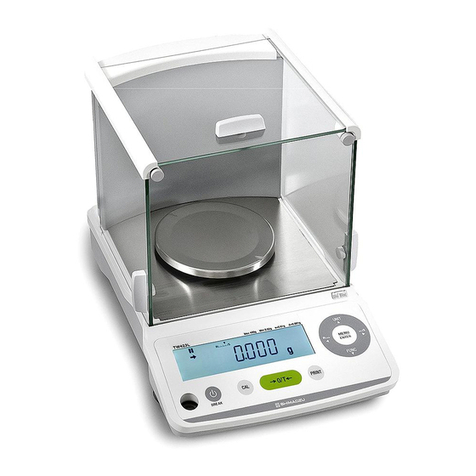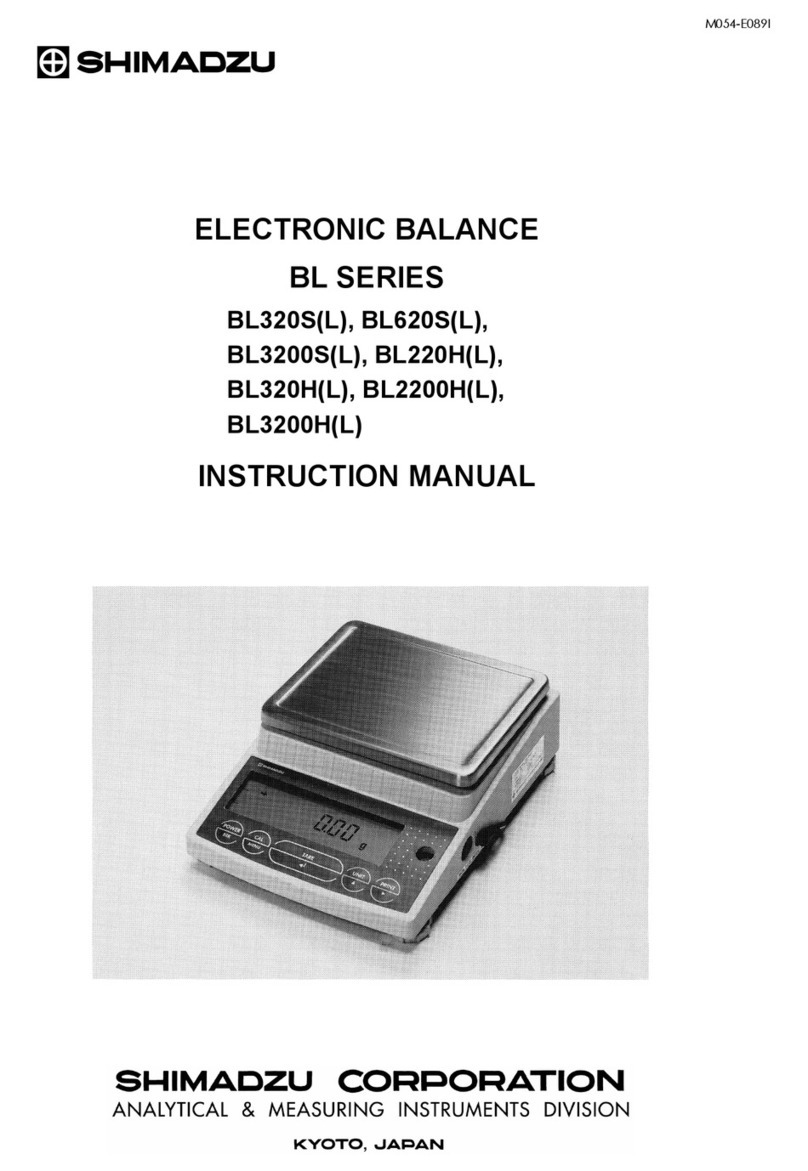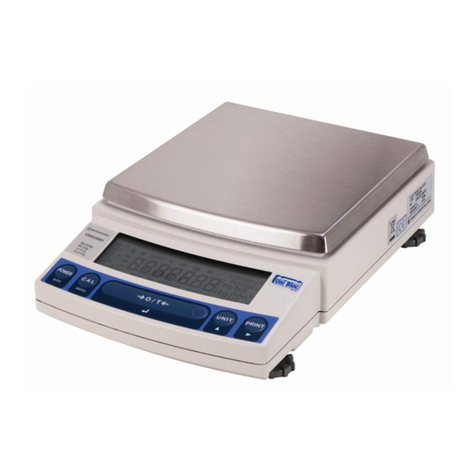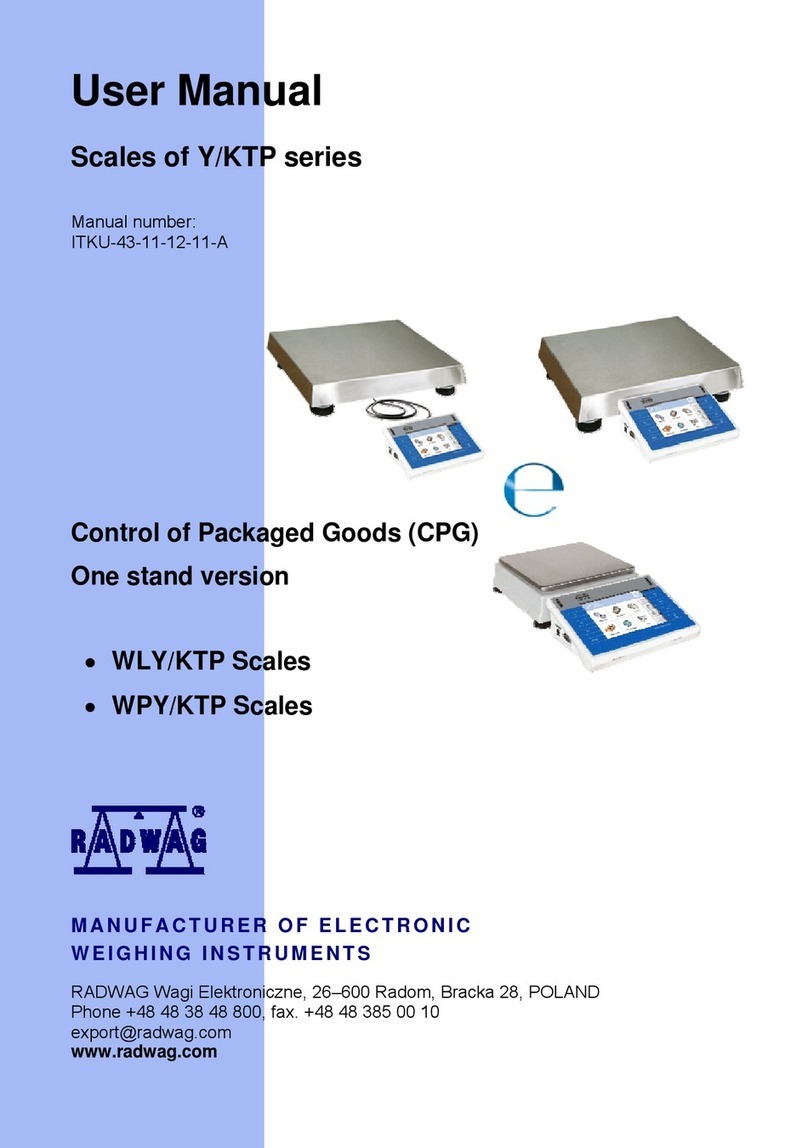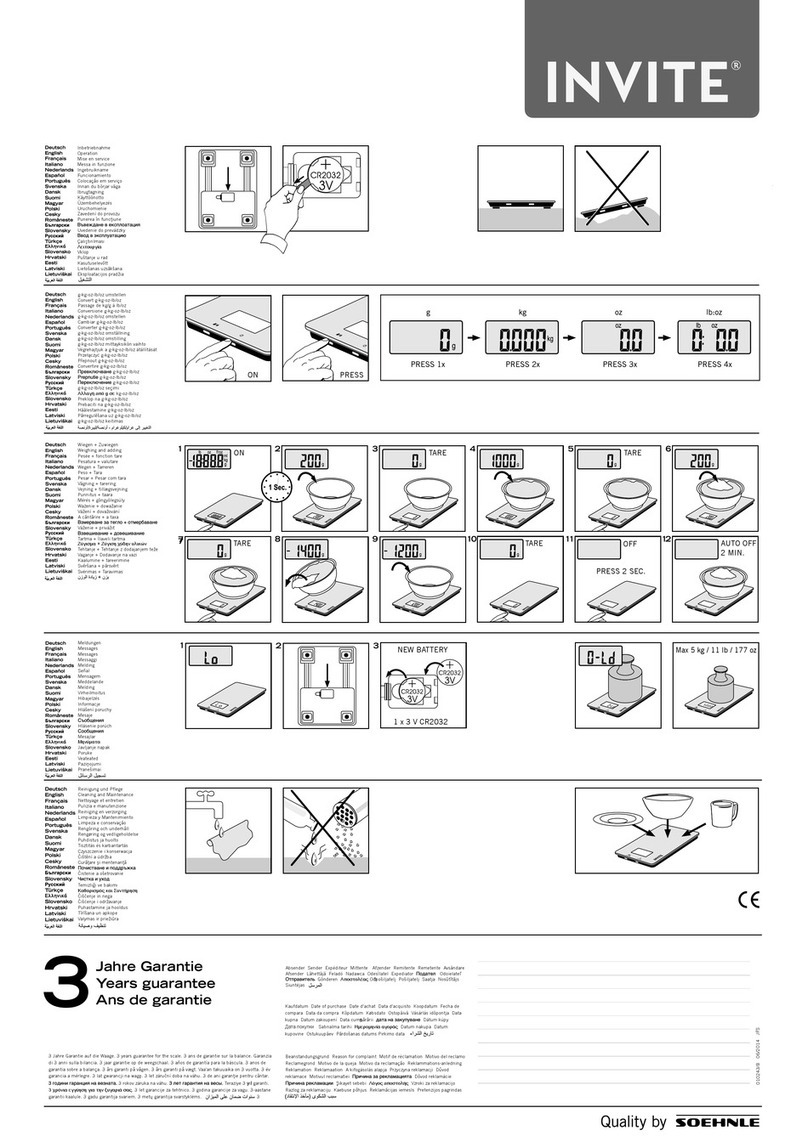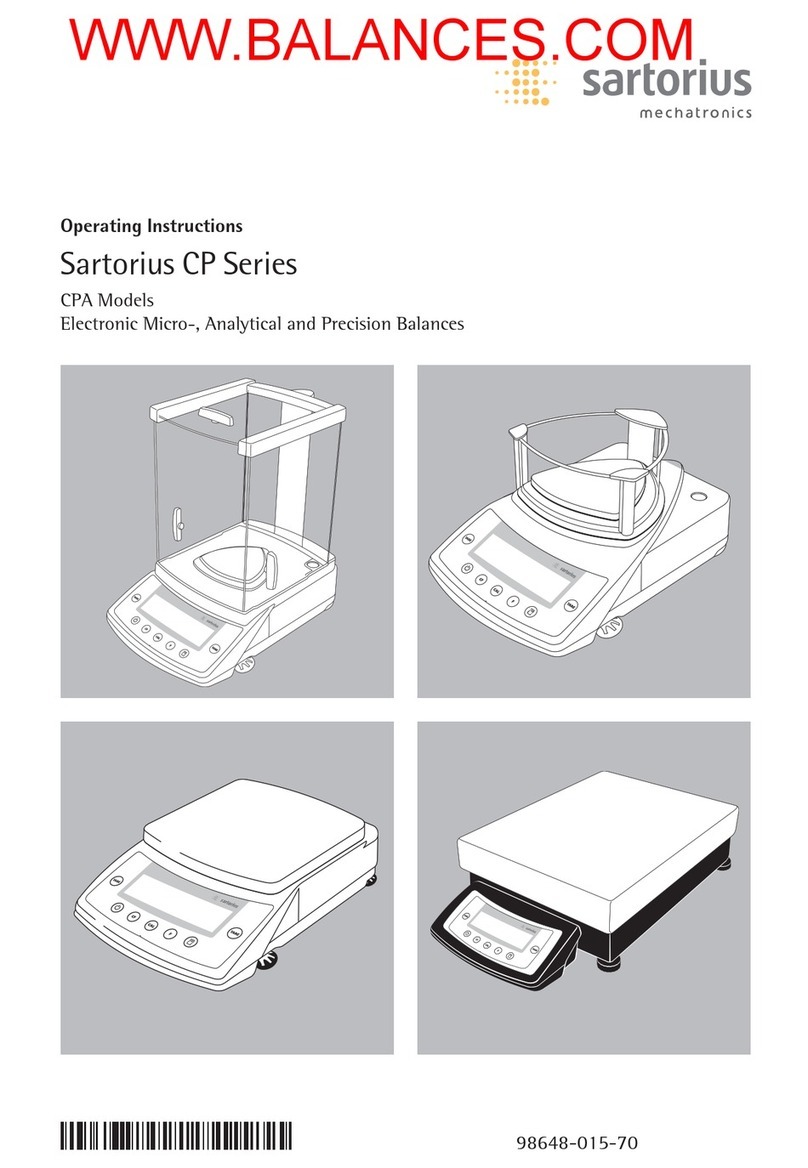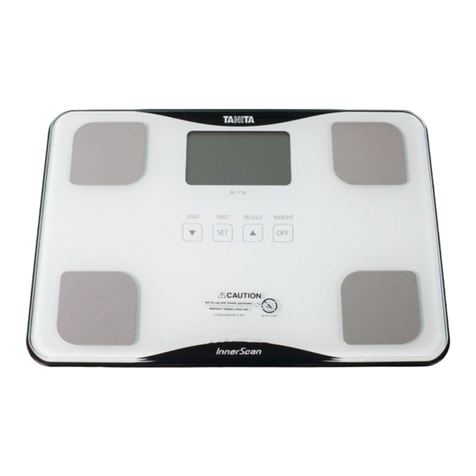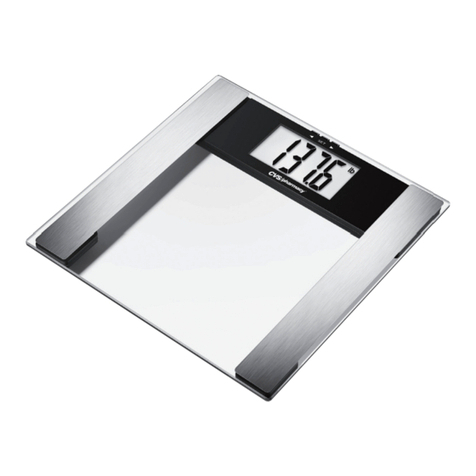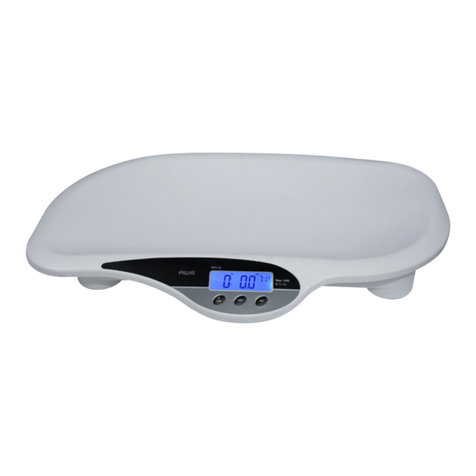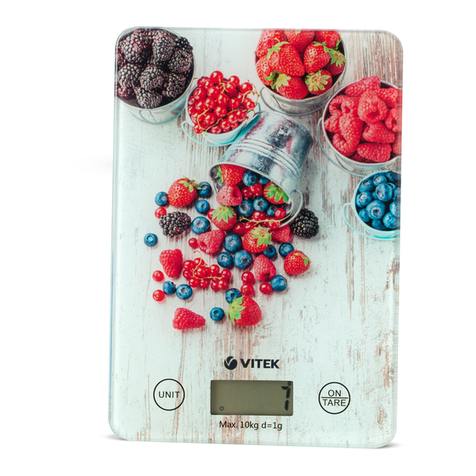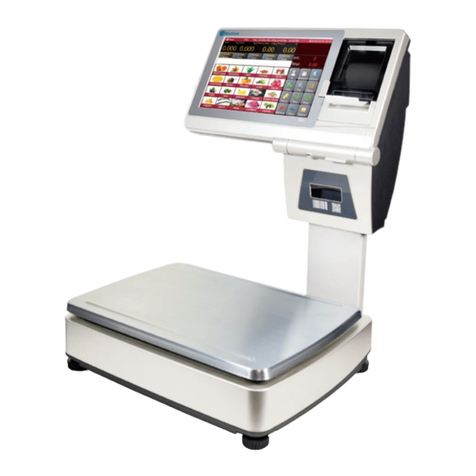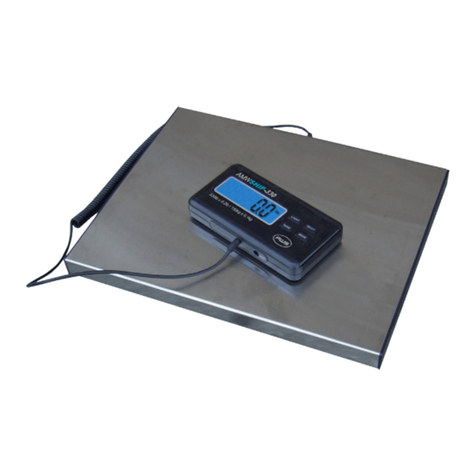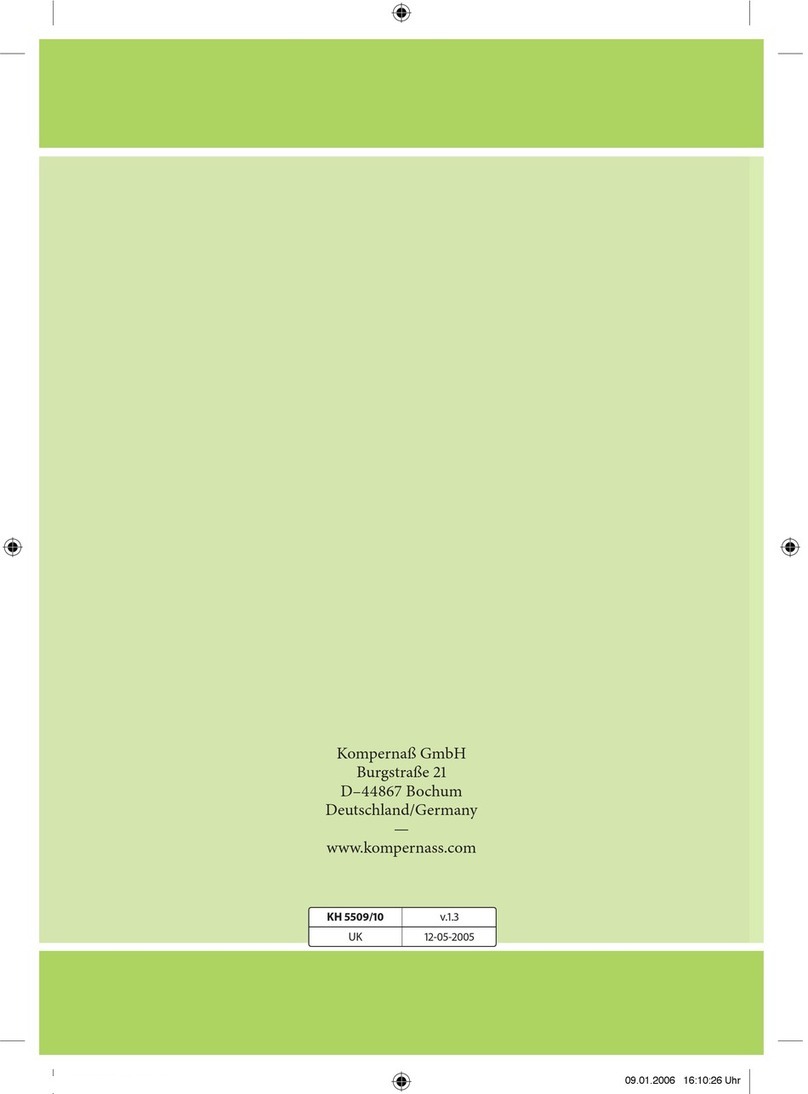Shimadzu UPX Series User manual

【 お願い 】修理品を発送されるときに...
・ 据付の際の製品純正の梱包箱を使用してください。
・ 皿、皿受けキャップ、風防等は必ず取外してお送りください。
・ UPXシリーズは輸送用固定ネジを時計回りに止まるまで回して、お送りください。
・ 天びん本体は輸送時の衝撃から保護するため、上下左右に十分緩衝材をあてがって
梱包してください。
Top-loading Balance
東 京 支 社 天びん営業課 [担当地域 北海道・東 北・関 東・甲 信 越・静 岡 県]
〒101-8448 東京都千代田区神田錦町1丁目3 TEL(03)3219-5705 FAX(03)3219-5610
関 西 支 社 天びん営業課 [担当地域 北陸・東 海(※)・近 畿・中国・四 国・九 州・沖 縄]
※静岡県は東京の天びん営業課の担当です。
〒530-0012 大阪市北区芝田1丁目1-4阪急ターミナルビル14階 TEL(06)6373-6662 FAX(06)6373-6526
Foreword
1.
2. Installation
3. Basic Operation
4.
Menu Item Selection
5.
Built-in Clock Set-up
6. Display Selection
7. Calibration
8. Environment
9.
Unit Display Set-up
10.
11.
12.
13.
14.
Troubleshooting
Appendices
S321-78282
Aug. 2019
UPX Series
UPY Series
UP223X, UP423X, UP623X, UP823X, UP1023X
UP422X, UP822X
UP2202X, UP4202X, UP6202X
UP4201X, UP8201X
UP223Y, UP423Y, UP623Y, UP823Y, UP1023Y
UP422Y, UP822Y
UP2202Y, UP4202Y, UP6202Y
UP4201Y, UP8201Y
Instruction Manual
UP0000x
3
UP0000x
3
UP0000x
3
https://www.an.shimadzu.co.jp/balance/index.htm
Read the instruction manual thoroughly before you use the product.
Keep this instruction manual for future reference.
Name and Function
of Components
Connections and
Communications with
External Equipment
Maintenance and
Transportation
Enhancing
Productivity
Application
Functions

No text

I
Foreword
Read the instruction manual thoroughly before using the product.
Thank you for purchasing the Shimadzu Top-loading Balance UP Series.
This instruction manual provides details on how to use the balance and on the accessories and options,
etc., that are related to it. Read the manual thoroughly and make sure it is used in accordance with the
details listed herein. The following instruction manual is also supplied with this product.
Simple Sheet: Operation Guide 321-78282 Operation descriptions in a simple diagram format.
Store the instruction manuals together with the product in an easily-accessible location.
The instruction manuals (PDF format) can also be downloaded from the Shimadzu website
(https://www.an.shimadzu.co.jp/balance/) Balances
SEARCH
Click
Notices
• If the balance is to be operated by a different user or transferred to a different location, make sure the
instruction manuals are also provided to the subsequent users.
• Contact the Shimadzu sales office or agency in the event of the instruction manuals were lost or
mislaid.
• Safety precautions are listed in the instruction manual to ensure safe usage. Read the section on
[Safety Precautions] thoroughly prior to using the balance.
• You are requested to complete the user registration procedure to ensure that your balance can be
used without anxiety. This is required when making claims against the product warranty, and you are
requested to complete either of the following two user registration procedures.
(1) Fill in the details on the rear of the [Product Warranty] card provided, and send it to us by facsimile.
(2) Access our website and will in the details accordingly.
(https://www.an.shimadzu.co.jp/balance/user/index.html)
Once you have completed the user registration procedures, you will be given precedence with
regard to receiving information on product warranty and Shimadzu products and services.
(You are also requested to fill in the questionnaire.)
Notices
• The content of this manual is subject, without notice, to modifications for the sake of improvement.
• Every effort has been made to ensure that the content of this manual was correct at the time
of creation. However, in the event that any mistakes or omissions are discovered, it may not be
possible to correct them immediately.
• The copyright of this manual is owned by Shimadzu Corporation. Reproduction and duplication of
whole or part of the content without permission of the company are strictly prohibited.
• Windows is the registered trademark of Microsoft Corporation of the U.S.A. in the United States
and other countries. All other company names and product names that appear in this manual are
trademarks or registered trademarks of the companies concerned. Note that ™ and ® indications
are not used.
• UniBloc and Smart+ are the registered trademarks of Shimadzu Corporation in Japan.
• Shimadzu does not guarantee that the serial communication functions will operate without problem
on all PCs. Shimadzu will not accept responsibility for any trouble that arises as a result of using this
function. It is recommended that all important data and programs are backed up in advance.
© 2019 Shimadzu Corporation. All rights reserved.

II
Foreword
Notation Conventions Used within the Instruction Manual
The instruction manual uses the following notation conventions in accordance with the degree of risk and
damage to equipment.
Notation Description
!Caution Indicates a potentially hazardous situation which, if not avoided,
may result in minor to moderate injury or equipment damage.
Note Provides additional information needed to properly use the
balance.
Descriptions of the other pictograms used within the instruction manual are listed below.
Pictogram Description
Prohibitions
Indicates an action that must NOT be performed
Instructions
Indicates an action that must be performed.
The functions available for use and the selectable items differ in accordance with the model with the UP
Series. Read the sections concerning the model in use.
Other conventions used in this manual include:
1, 2, 3, … Indicates the step number in a procedure
[POWER] key Indicates the operation key on the balance.
[E-CAL ] etc...
Items displayed on the balance display are shown in [ ] brackets.
This also includes displayed items when selecting a menu item and is also used to identify
menu items.
mass display Indicates that the balance is in the weighing mode and mass is displayed in one of the
weighing units.
Mass display Indicates that the balance display is in one of the mass units and that the value displayed will
change according to the load on the pan.
1Indicates the menu item to be selected.
In the number of the menu item on the Menu Map. See A-2 “Menu Map”.

III
The UP Series comprises of the Top-loading equilibrium balances mounted with aluminum UniBloc sensors. This
instruction manual provides details on operating the UP Series models listed below. The functions available differ
in accordance with the model, so check the product label located on the front or back of the balance and read the
sections concerning the model in use.
About the model name
Example: UP223X
Model
name
Capacity
22: 220g
42: 420g
62: 620g
82: 820g
102: 1020g
220: 2200 g
420: 4200 g
620: 6200 g
820: 8200g
Minimum display
1: 0.1 g
2: 0.01 g
3: 0.001 g
Series name
X : X Series (with built-in
calibration weight)
Y : Y Series
UP Lineup UPX Series UP223X UPY Series UP223Y
Small pan type
UP423X
Small pan type
UP423Y
UP623X UP623Y
UP823X UP823Y
UP1023X UP1023Y
UP422X UP422Y
UP822X UP822Y
Large pan type
UP2202X
Large pan type
UP2202Y
UP4202X UP4202Y
UP6202X UP6202Y
UP4201X UP4201Y
UP8201X UP8201Y
For information on the following points, please contact your Shimadzu Balance representative.
• Product warranty
• After service
UP Series

IV
Precautions on Use
To be strictly observed
To ensure that you use the balance safely and correctly, read the following precautions carefully. The details listed
below provide important information on safety, and must be observed at all times.
■Precautions Related to Usage
!CAUTION
Prohibitions Cannot be used as proof of transactions.
The balance is not permitted by law to be used as proof of transaction for drug formulation, etc.
■Precautions Related to Place of Installation
!CAUTION
Prohibitions
Do not use the balance outdoors or anywhere where it will be exposed to water.
You could sustain an electric shock or the product could operate abnormally.
Prohibitions
Avoid locations where the balance will be exposed to volatile gas, flammable
gas or corrosive gas.
Failure to observe this may result in the outbreak of fire and accidents.
Prohibitions
Avoid locations where the balance will
be exposed to any of the following.
This could cause accidents or poor performance.
• Air flow from an air conditioner, ventilator, door or
window
• Extreme temperature changes
• Vibration
• Direct sunlight
• Dust, electromagnetic waves or a magnetic field
• Condensation
Instructions Install the balance on a strong and stable flat table or floor.
Placing the balance in an unstable site could lead to injury or trouble with the balance. When selecting the
installation site, take into account the combined weight of the balance and the item to be weighed.
Safety Precautions

V
Safety Precautions
■Precautions Related to Installation Work
!CAUTION
Prohibitions
Do not connect anything other than peripheral devices specified by Shimadzu to the balance’s connector.
If you do, the balance may stop working normally. In order to avoid trouble, always connect peripheral devices
in accordance with the directions in this manual.
Instructions Use the correct power supply and voltage with the AC adapter supplied.
Using the balance with an incorrect power supply or voltage may result in the outbreak of fire or malfunctions. Note also that if the power supply
or voltage is unstable or if the power supply capacity is insufficient, it will not be possible to obtain satisfactory performance from the balance.
Instructions The included AC adapter is for use with this product only.
Do not use the included AC adapter with any other devices. Doing so could cause fires or other damage.
Instructions
Install measures to prevent the balance from toppling over in the event of earthquakes, etc.
If the balance topples over as a direct result of vibrations, it may result in injury.
Instructions
Plug the AC adapter into an easily accessible power outlet.
During emergencies, it is necessary to unplug the AC adapter from the power outlet.
Instructions Beware of the gaps between equipment during installation.
Failure to observe this may result in fingers getting caught, leading to injury. Place fingers on the indentations
on the sides of the unit and grip it firmly with both hands during installation.
■Precautions Related to Work/Operations
!CAUTION
Instructions
Use the correct weighing units.
Using incorrect weighing units can lead to accidents as a result of weighing errors. Check that the weighing
units are correct before starting weighing.
Instructions Treat the balance with care and respect.
The balance is a precision instrument. Subjecting it to impact may result in malfunctions. When moving the balance, remove the pan,
the pan supporter the shield plate, fix the glass draft shield, the Draft shield inner plate, the Power pack, the Stage, the Shield case
and the Multi-stand, etc in place, and grasp it firmly with both hands when carrying it. If the balance is to be stored for long periods of
time, place it in the packaging box which was used for delivery and store it in a safe location with few temperature fluctuations.
■
Risks Involved in Repairs/Dismantling/Modifications
!CAUTION
Prohibitions Never disassemble, modify or attempt to repair this product or any accessory.
You could sustain an electric shock or the product could operate abnormally. If you believe that the balance
has failed, contact your Shimadzu representative.

VI
Safety Precautions
■Precautions Related to Inspections/Maintenance
!CAUTION
Prohibitions
The design standard period of usage for this product is ten years. Using
the product for more than the design standard period may result in it being
impossible to maintain performance or malfunctions, etc.
• A fee is charged for safety inspections. Direct all requests to our sales offices, dealers or the service
agencies specified by the company.
• The design standard period is the standard period during which the product can be used safely without
malfunctions, and it does not represent the valid period of product warranty.
• See [Chapter 13. Maintenance and Transportation] for details on daily maintenance inspections and
replacement parts.
Instructions
Unplug the power cord from the AC adapter during inspections, maintenance and
when replacing parts.
Failure to observe this may result in accidents caused by electric shocks or short-circuits.
Instructions Always use the parts specified in the instruction manual when replacing parts.
The use of non-specified parts may result in them becoming damaged and unusable.
■Measures to be Observed during Emergencies
!CAUTION
Instructions
If you detect anything abnormal (e.g. a burning smell), immediately disconnect the
AC adapter from the power outlet.
Continuing to use the balance with an abnormality could lead to fire or an electric shock.
■Measures to be Observed during Power Outages
!CAUTION
Instructions After a power outage, turn the power back ON.
When a power outage occurs, the power is shut off automatically. Therefore, begin operation from “Turning on
the Power” (P.15) again.
■Caution Labels
Cautions labels are placed in necessary locations on the balance to ensure that it is used correctly. In the event of
these labels being mislaid or damaged, contact a Shimadzu sales office or service agency to request new labels,
and then make sure they are situated in the correct locations.
[UP223X example]
DATA I/ORS232C AUX KEY DC IN
Use the AC adapter supplied
with the specified power supply

VII
Safety Precautions
■Residual Risk Information
Residual risk refers to the risks that could not be removed or reduced during the design and manufacturing stages.
Check the [Residual Risk Maps] for each area with inherent risks and implement protective measures while
referring to the [List of Residual Risks].
■Residual Risk Maps
The [Equipment Location] and [No.] shown below match up with the [List of Residual Risks].
Refer to the [List of Residual Risks] for further details.
UP0000x
3
UP0000x
3
UP0000x
3
Location A: Windbreak set
! Caution No.1
Location B: Pan
! Caution No.3
Location C: Large pan windbreak
! Caution No.2
■List of Residual Risks
The [No.] and [Equipment Location] shown below match up with the [Residual Risk Maps].
Check the [Residual List Maps] for further retains on the relevant [Equipment Location].
Read and fully comprehend the details listed in [Refer To] and implement protective measures without fail.
Measurement Preparations
No.
Equipment Location
Risk
Protective Measures Implemented by Users
— —
1 A ! Caution
If you attempt to move the
balance while holding the
windbreak set, the windbreak
will detach from the balance.
When moving the balance, do not hold
the windbreak set, instead securely hold
the main body from the bottom using
both hands.
Refer To
P10
Task Moving the
Balance
Qualifications
& Training
Recipients of
Work Training
2 C ! Caution
When setting the large pan
windbreak, holding it by the
corners could cause you to cut
your hands.
When installing the windbreak, do not
hold it by sharp edges when placing.
Refer To
P12
Task Windbreak
installation
Qualifications
& Training
Recipients of
Work Training
Maintenance
No.
Equipment Location
Risk
Protective Measures Implemented by Users
— —
3 A ! Caution
Transporting the balance with
the pan and pan supporter
installed could result in damage
to the main body.
Always remove the pan and pan
supporter when transporting the
balance for repair.
Refer
To
P10
Task Transporting
during repairs
Qualifications
& Training
Recipients of
Work Training

VIII
Safety Precautions
Product Warranty
Shimadzu provides warranty with regard to the following as a basic principle. See the [Product Warranty]
supplied for further details.
1. Period of Warranty
Valid for one year from the date of purchase. (Restricted to Japan).
2. Items Covered by the Warranty
Malfunctions attributable to Shimadzu occurring within the period of warranty will be repaired or parts
replaced free of charge. (The warranty is only valid within Japan).
3. Limitation of Liability
1) Shimadzu cannot be held responsible for the users’ loss of profit, indirect damages or secondary damages
under any circumstances. The company can also not be held responsible for damages relating to damage
compensation caused to users by third parties.
2) The liability for compensatory damages attributable to Shimadzu is limited to a sum equivalent to the cost of
the product in all cases.
4. Warranty Exemption
The warranty is not valid for malfunctions attributable to the following, even during the period of warranty.
1) Malfunctions occurring as a result of misuse.
2) When the product is repaired or modified, etc., by any company or person other than Shimadzu Corporation.
3) Malfunctions attributable to causes other than the product itself.
4) When used in harsh environments, such as high-temperature and high-humidity environments, environments
subject to corrosive gases, and environments subject to vibrations, etc.
5) Malfunctions caused by fire, earthquakes or other natural disasters, by contamination caused by radioactivity
or toxic substances, or by unavoidable situations, such as war, civil unrest and crime.
6) When moved or transported elsewhere after having been installed.
7) Consumable parts and parts conforming to this designation.

IX
Safety Precautions
Aftercare Services and Part Supply Period
1. Aftercare Service
In the event of the product not operating normally, carry out inspections and resolve the problem in
accordance with the instructions providing in [14.Errors and Recovery] ( P.91). If the problem persists or
other problems that are thought to be malfunctions not covered by the instructions provided arise, contact
the numbers provided on the back cover.
2. Part Supply Period
The period during which replacement parts will be supply for the product is up until seven years after the
termination of manufacture.
Note that there are cases in which it will not be possible to supply replacement parts once this supply
period has elapsed. However, the supply periods stipulated separately by the manufacturers will be
applied for parts not manufactured by Shimadzu.
Inspections and Maintenance
Daily inspections, Periodic inspections and regular calibrations are required to ensure that the
performance of the balance is maintained for long periods of time so that correct measurement data can
be acquired.
• See [Chapter 13. Maintenance/Inspections] for details on daily inspections and part replacement.
• Contact a Shimadzu sales office or service agency, or one of Shimadzu’s service companies to request
Periodic inspections and regular calibrations.
Product Disposal
When disposing of the product, dismantle and dispose of the parts separately in accordance with their
composition in order in consideration of environmental conservation.
Direct all inquiries to the contact numbers provided on the back cover.

X
Safety Precautions
Shimadzu Balances and 21 CFR Part 11
21 CFR Part 11
21 CFR Part 11, Electronic Records, Electronic Signatures, Final Rule (often referred to as Part 11) is the
United States Food and Drug Administration (FDA) regulation affecting computer resources and electronic
records that are used for any document that is required to be kept and maintained by FDA regulations.
Requirements concerning computer resources security are key elements in Part 11.
The controls implemented as a result of security related requirements are intended to result in trusted
records.
Shimadzu Lab Solutions Balance
Shimadzu provides a means for compliance with 21 CFR Part 11 with Shimadzu Lab Solutions Balance
software, part of a comprehensive laboratory data management system, Shimadzu Lab Solutions.
Ask your Shimadzu representative about it.
Two-way Communication
Shimadzu balances have always been computer friendly and they can be set up for bi-directional
communication as part of a fully automated production system or LIMS.
This manual includes the command codes and information needed by programmers to integrate
Shimadzu balances with their software.
Action for Environment (WEEE)
To all user of Shimadzu equipment in the European Union:
Equipment marked with this symbol indicates that it was sold on or after 13th August 2005,
which means it should not be disposed of with general household waste. Note that our equipment is for
industrial/professional use only.
Contact Shimadzu service representative when the equipment has reached the end of its life.
They will advise you regarding the equipment take-back.
With your co-operation we are aiming to reduce contamination from waste
electronic and electrical equipment and preserve natural resource through
re-use and recycling.
Do not hesitate to ask Shimadzu service representative, if you require further
information.
For Caifornia, USA Only
This product contains a battery that contains perchlorate material.
Perchlorate Material - special handling may apply.
See www.dtsc.ca.gov/hazardouswaste/perchlorate
WEEE Mark
Safety Precautions

XI
Foreword.......................................................I
UP Series .................................................... III
Safety Precautions.....................................IV
Precautions on Use ............................................ IV
■Precautions Related to Usage......................... IV
■Precautions Related to Place of Installation..... IV
■Precautions Related to Installation Work .......... V
■Precautions Related to Work/Operations .........V
■
Risks Involved in Repairs/Dismantling/
Modifications ..............................................V
■Precautions Related to Inspections/
Maintenance ........................................... VI
■Measures to be Observed during
Emergencies .......................................... VI
■Measures to be Observed during Power
Outages .................................................. VI
■Caution Labels ................................................ VI
■Residual Risk Information............................... VII
Aftercare Services and Part Supply Period.......... IX
Inspections and Maintenance.............................. IX
Product Disposal ................................................. IX
Shimadzu Balances and 21 CFR Part 11 .............. X
Action for Environment (WEEE)............................. X
Table of Contents .......................................XI
1. Name and Function of Components..1
1.1 Components............................................ 1
1.2 Key Panel and Operation ......................... 3
1.3 Balance Display and Function.................. 4
2. Installation...........................................5
2.1 Choosing the Installation Site................... 5
2.2 Unpacking and Delivery Inspection.......... 7
2.3 Installation.............................................. 10
2.4 Turning on the Power ............................. 15
2.5 Span Calibration .................................... 16
3. Basic Operation The balance can
be used correctly according to the
content of Chapters 1 to 4................ 19
3.1 Weighing................................................ 19
3.2 Changing the Unit Display...................... 20
4. Menu Item Selection (Read Chapters
4 to 12 before using the balance).....21
4.1 What is the Menu? ................................. 21
4.2 Menu Map.............................................. 21
4.3 Menu Item Selection Procedure............. 22
4.4 Setting Numeric Values.......................... 25
4.5 Related Useful Functions ....................... 26
4.5.1 Last Menu Recall....................... 26
4.5.2 Returning to the Default Settings
(menu reset) .............................. 26
4.5.3 Menu Lock ................................ 27
5. Built-in Clock Set-up......................... 28
5.1 Date ....................................................... 28
5.2 Date Output Style .................................. 28
5.3 Time....................................................... 29
5.4 Setting Display During Stand-by ............ 29
6. Display Selection ..............................30
6.1 Bar graph display................................... 30
6.2 Changing the Minimum Display Digit .....30
7. Calibration ......................................... 31
7.1 What is calibration?................................ 31
7.2 Calibration Execution ............................. 32
7.2.1 Span Calibration Using the Built-in
Weight (UPX Series Only) .......... 32
7.2.2 Calibration Check Using the Built-
in Weight (UPX Series Only)....... 33
7.2.3 Span Calibration Using External
Weights ..................................... 35
7.2.4 Calibration Check Using External
Weights .....................................36
7.3 Calibration Setting.................................. 37
7.3.1 Selecting the Calibration Type ... 37
7.3.2 PSC Fully-automatic Calibration
(UPX Series only)....................... 37
7.3.3 Clock-CAL Fully-automatic
Calibration (UPX Series only)..... 39
7.3.4 PCAL: Calibration of the Built-in
Weight (UPX Series only) ........... 40
7.3.5 PCAL Password Setting (UPX
Series only)................................ 41
7.4 Maintaining Calibration Reports… GLP/
GMP/ISO Compliant Measurement
Management Systems ........................... 42
7.4.1 Calibration Report Setting......... 42
7.4.2 Balance ID Setting..................... 42
8. Environment ......................................43
8.1 O ve r vi ew ................................................ 43
8.2 Stability and Response (Averaging)........43
8.3 Stability Detection and Settings............. 45
8.3.1 Stability Detection Band............ 45
Table of Contents

XII
8.3.2 Timing of Stability Mark
Illumination and Data Output..... 46
8.4 Tracking ................................................. 46
9. Unit Display Set-up ........................... 47
9.1 Units....................................................... 47
9.2 Percentage (%) Conversion.................... 48
10. Enhancing Productivity ....................49
10.1 Checkweighing and Target Display ........ 49
10.1.1 Checkweighing (Comparator)
Display Type 1 ........................... 50
10.1.2 Checkweighing (Comparator)
Display Type 2 ........................... 50
10.1.3 Target Mode.............................. 51
10.2 Piece Counting (PCS)............................. 52
10.3 Automatic Printing and Output
(Auto Print) ............................................. 53
10.4 Automatic Compensation of Zero Point
Drift (Auto Zero)...................................... 55
10.5 Sample Loading and Unloading
Determination (Zero Range) ................... 56
10.6 Taring/Printing at Stability ...................... 57
10.7 Registering Container Weight (Pretaring
Value) ..................................................... 58
11. Application Functions.......................59
11.1 Solid Specific Gravity Measurement ...... 59
11.2 Liquid Density Measurement ................. 62
11.3 Detecting Peak Values (Peak Hold) ........ 65
11.4
Outputting at Fixed Times (Interval Timer) ....... 67
11.5 Measuring a Large Number of Small
Samples (Add-on Mode) ........................68
11.6 Animal Weighing mode .......................... 70
11.7 Formulation Mode.................................. 73
12. Connections and Communications
with External Equipment .................. 75
12.1 Connecting Printers ............................... 75
12.2 Connecting Personal Computers........... 76
12.3 Connecting PLCs and Other Serial
Communications Equipment.................. 78
12.4 Cable Connections (RS232C) ................ 79
12.4.1 Connecting the Cable ............... 79
12.4.2 Data Format .............................. 80
12.4.3 Using Command Codes............ 82
12.5 Communication Setting ......................... 87
12.5.1 Overview ................................... 87
12.5.2 Handshaking............................. 87
12.5.3 Format....................................... 88
12.5.4 Communication Speed .............88
12.5.5 Parity / Bit Length .....................88
12.5.6 Stop Bit ..................................... 89
12.5.7 Delimiter ....................................89
12.6 Decimal Point Symbol in Output Data.... 89
13. Maintenance and Transportation.....90
13.1 Maintenance ..........................................90
13.2 Moving the Balance ...............................90
14. Troubleshooting ................................ 91
14.1 General Display...................................... 91
14.2 Error Display .......................................... 92
14.3 Troubleshooting ..................................... 93
14.4 LCD (Liquid Crystal Display) Check........ 93
Appendices ...............................................94
A-1. Specifications ........................................ 94
A-2. Menu Map.............................................. 96
A-3. Standard Accessories and Maintenance
Parts List.............................................. 101
A-4. Optional Accessories List..................... 102
A-5. RS-232C/Specifications of Connectors103
A-6. Unit Conversion Coefficient List........... 104
A-7. Performance Checks ........................... 105
A-8. Below-Weigh Hook Dimensions........... 106
A-9. Index .................................................... 107
Table of Contents

1
2
4
1
3
5
6
7
11
13
12
8
9
10
14
1.1 Components
a. Large pan model
UP0000x
3
Pan
Supports the object to
be weighed
Large pan windbreak
Even light breezes can have an effect on
measurements, so the windbreak protects
against wind.
The windbreak is not included with models
with a minimum display of 0.1 g.
Labe
l
Sh
ows model name. "Max"
an
d "d" are indications
re
quired by legal metrology,
w
hich do not restrict the
we
ighing range in general
us
e.
Main body
Display panel
Shows weighed result, information
on programming function, indicates
current setting, working function,
necessary operation, and error message
Operatio
n keys
Used
to tare, execute calibration
an
d functions, program functions,
inpu
t numerical values Level screws
Adjust to level the balance
b. Small pan model (minimum display 0.001g, windbreak standard)
Windbreak set
Even light breezes can have an effect on
measurements, so the windbreak pr
otects against
wind.
Pan
Supports the object to be weighed
Label
Shows model name.
"Max" and "d" ar
e
indications r
equired by
legal metr
ology, which do
not r
estrict the weighing
range in general use.
Main body
Display panel
Shows weighed result, information
on programming function, indicates
current setting, working function,
necessary operation, and err
or message
Operation keys
Used to tar
e, execute calibration
and functions, pr
ogram functions,
input numerical values
Level screws
Adjust to level the balance
UP0000x
3
UP0000x
3
1. Name and Function of Components

2
1. Name and Function of Components
a,b. Common
RS-232C
Connector
DATA I/O
Connector
DC IN
Connector
AUX
Connector
(Connectors on the back)
KEY Connector
下皿フックキャッ
プ
Below-weigh hook cap
Theft preventing ring
Ground terminal
Connect this terminal to ground if necessary
Transportation screws
(only for UPX Series)

3
1. Name and Function of Components
2
4
1
3
5
6
7
11
13
12
8
9
10
14
1.2 Key Panel and Operation
POWER
PRINT
UNIT
CAL
O/T
UP1023X
1020g
Max
d= 0.001g
[PRINT] key[CAL] key[POWER] key [UNIT] key[O/T] key
Functions of the keys
Key During Weighing
Press Once and Release Press and Hold for About 3 Seconds
[POWER] Switches between the operation and standby
modes.
Exits the application function and returns to
the mass display.
[CAL] Enters span calibration or menu item selection.
(*1)
Displays the last menu item that was set. (Last
menu recall)
[O/T] Tares the balance. (Displays zero.) (*2) Displays the Pretare value. (*6)
[UNIT] Changes the weighing unit or selects the
specific gravity measurement. (*3)
Switches between the 1d and 10d displays.
(*4) (*7)
[PRINT] Sends the displayed value to a peripheral
device.
Sends the date and time to a peripheral
device. (*6)
*1This key is used to set values when percent (%), number (PCS), solid specific gravity ( d), or liquid specific gravity (d)
are displayed.
*2When a Pretare value is set, zero is not displayed and [-Pretare value] is displayed.
*3Units other than “g” must be set up before they can be used for measurement. Only gram (g), percent (%), and piece
counting (PCS) are set-up before shipment.
*4When the unit is set to 10d, the resolution of the minimum display is decreased by one decimal place.
*5In Pouring mode (See 8.2), the right-most part of [O/T] key marked with a circle functions as the switch for
environmental condition setting. Otherwise this part functions the same way as the other parts of [O/T] key.
*6Either “Taring” (at a weight exceeding 2.0% of the capacity) or “Zeroing” ( at a weight within 2.0% of the capacity)
takes place with a verified balance as a legal measuring instrument in using region.
*7Not applicable to a verified balance as a legal measuring instrument in using region.
Key During Menu Item Selection
Press Once and Release Press and Hold for About 3 Seconds
[POWER] Returns to the previous menu level Returns to the mass display.
[CAL] Moves to the next menu item. Displays the last menu item that was set. (Last
Menu Recall)
[O/T] Selects or sets the currently displayed menu
item, or enter into the displayed menu. No operation.
[UNIT] Increases the numeric value of the blinking digit
by 1. No operation.
[PRINT] Moves to the next digit during numeric value
entr y. No operation.

4
1. Name and Function of Components
1.3 Balance Display and Function
%NETBPTG
PCS lbGN
mg mom
kg
ctdwt
oztl
BATT
#
AP WARM-UPSTAND-BY
HI
GO
LO
Analog display sectionUnit display section
Display Name Description
Stability mark Indicates that the weighed value is stable. (*1) In menu item selection, this
symbol indicates currently selected item. (*1)
Tare symbol Indicates that a Pretare value has been set. (*3)
Weight symbol
Illuminates during span calibration.
Blinks before automatic span calibration starts.
Note: Using a verified balance as a legal measuring instrument in
using region:
When PSC fully-automatic span calibration is not activated, operator must
carry out span calibration with the built-in weight upon blinking of this symbol.
[ ] Bracket
Note: Using a verified balance as a legal measuring instrument in
using region:
The figure bordered by the bracket is the auxiliary indicating device.
Number symbol Indicates numeric value entry.
Menu symbol Illuminates during menu item selection.
*Asterisk Indicates that the displayed numeric value is not a mass value. (*2)
Communication symbol Illuminates during communication to external equipment through the
RS-232C or DATA I/O connector.
Inverse triangle symbol Indicates the set-up of solid specific gravity measurement. Used as a
substitution of the decimal point.
Zero symbol
Indicates the set-up of Auto Zero function.(*3)
Note: Using a verified balance as a legal measuring instrument in
using region:
Indicates that the balance is set exactly to "Zero" with the zero-setting
function(+/- 0.20e: e = verification scale interval).
Animal symbol Indicates the set-up of Animal Weighing function.(*3)
Add-on symbol Indicates the set-up of Add-on mode or Formulation mode.
Memory symbol Displays when the net total mass measurement function (memory
function) is ON.
Auto Print symbol Indicates the set-up of Auto Print function.
Stand-by symbol Illuminates when the balance power is in the standby mode.
Also illuminates when the application function has entered the standby mode.
Response stability
setting symbol Displays to indicate response stability setting status.
*1Stability mark The displayed value may change while the stability symbol remains illuminated if the load is
changing slowly or if the stability detection band has been set to a large value.
*2Decimal replacement If there are any decimals to the right of 7 digit numbers, this will be displayed to indicate the
presence of the decimals that are not displayed.
*3Not applicable to a verified balance as a legal measuring instrument in using region

5
2
4
1
3
5
6
7
11
13
12
8
9
10
14
2.1 Choosing the Installation Site
(1) Power supply
Select an installation site with a power source that allows for proper use of the included AC adapter.
Verify that the supply power voltage conforms to that indicated on the AC adapter.
(2) Installation site
!Caution
Avoid sites where the balance will be exposed to the following:
• Air flow from air-conditioner, open window, or ventilator
• Vibration
• Direct sunlight
Continued
2. Installation
This manual suits for next models
25
Table of contents
Other Shimadzu Scale manuals
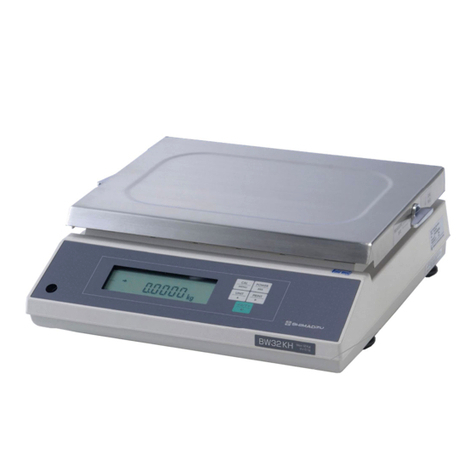
Shimadzu
Shimadzu BX32KS User manual
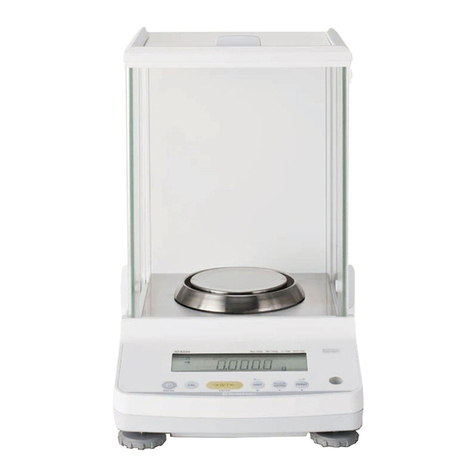
Shimadzu
Shimadzu ATX224 User manual
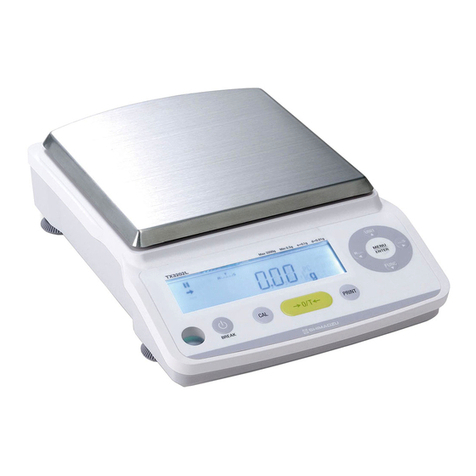
Shimadzu
Shimadzu TW Series User manual
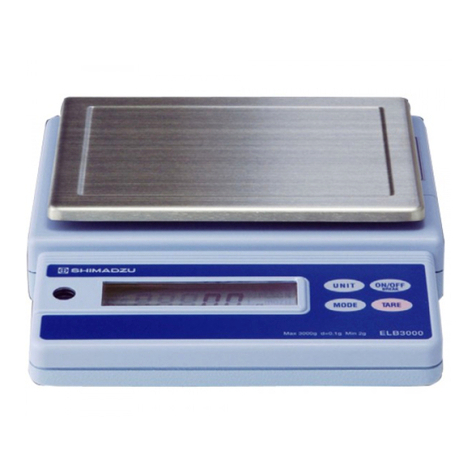
Shimadzu
Shimadzu ELB120 User manual

Shimadzu
Shimadzu ATX224 User manual

Shimadzu
Shimadzu AW Series User manual
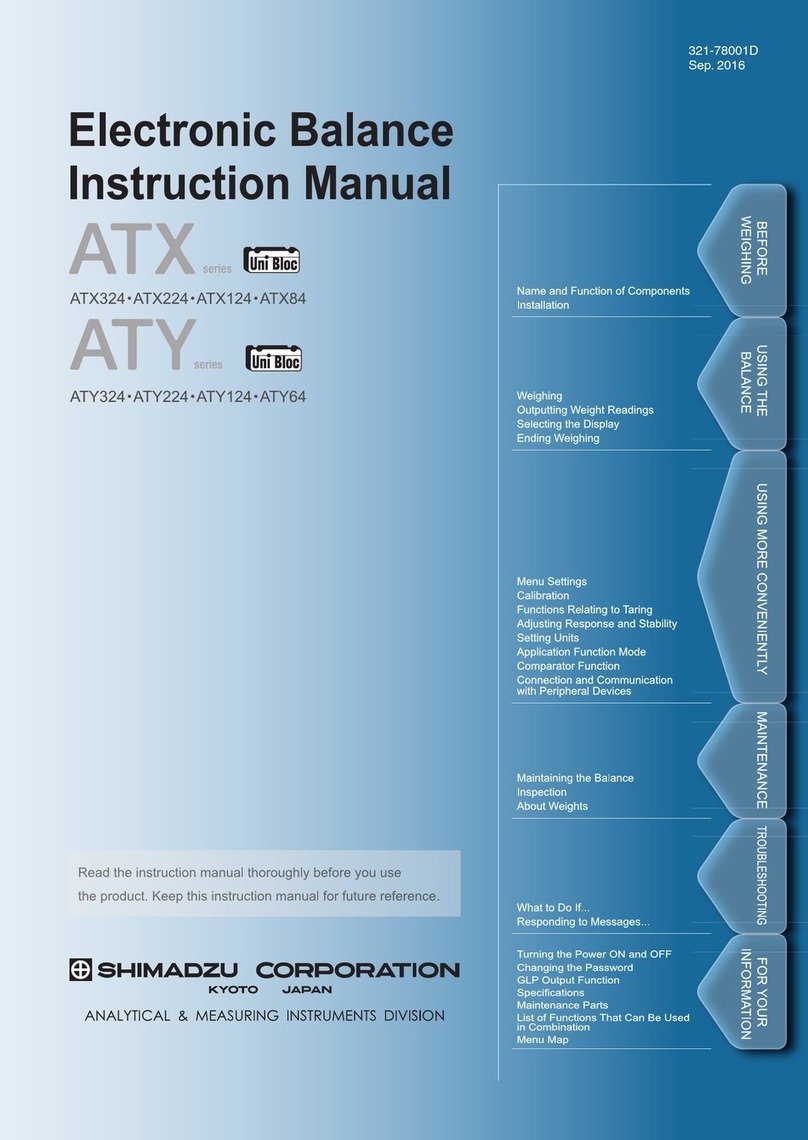
Shimadzu
Shimadzu ATX Series User manual
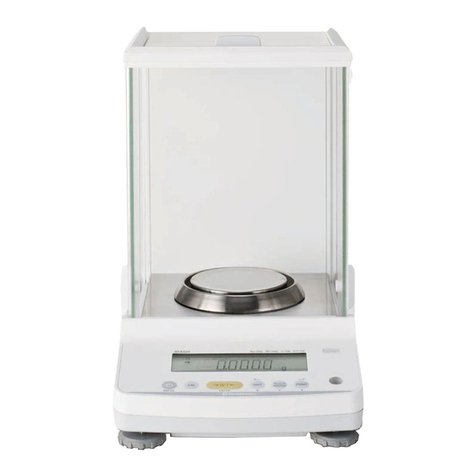
Shimadzu
Shimadzu ATX-R Series User manual
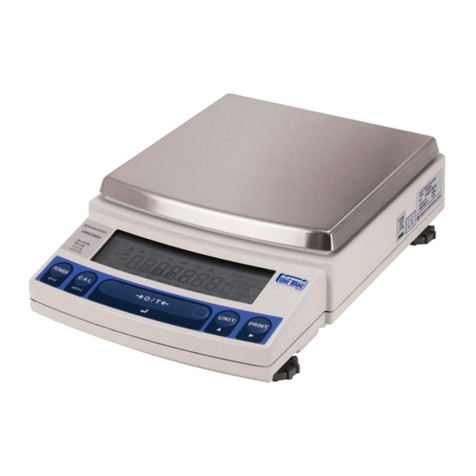
Shimadzu
Shimadzu UW220H User manual
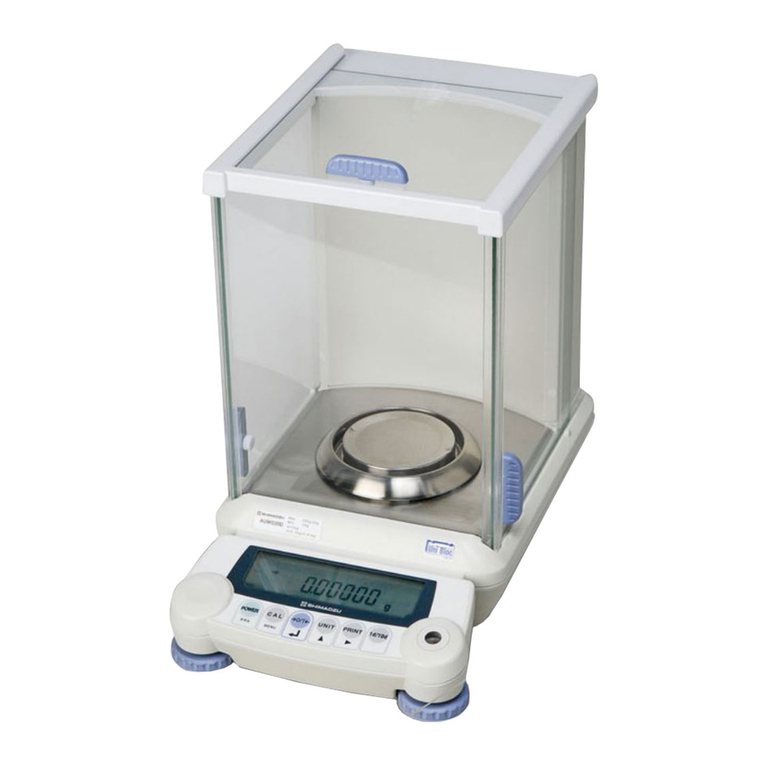
Shimadzu
Shimadzu AUW220D User manual

